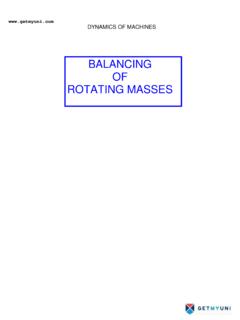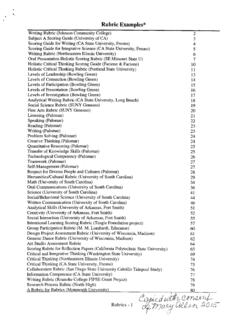Transcription of Unit 4 Lecturer notes of Assignment Problem of OR by Dr. G.R
1 1 Assignment Problem The Assignment Problem is a special case of transportation Problem in which the objective is to assign m jobs or workers to n machines such that the cost incurred is minimized. JOBS 1 2 -------- n 1 2 -- WORKERS -- -- n The element Cij represents the cost of assigning worker I to job (I,j= 1,2,---n). There is no loss in generality in assuming that the number of workers always equals the number of jobs because we can always add fictitious (untrue or fabricated) workers or fictitious jobs to effect this result.
2 The Assignment model is actually a special case of the transportation model in which the workers represent the sources and the jobs represent the destinations. The supply amount at each source and the demand amount at each destination exactly equal 1. C11 C12 ---------------- C1n C21 C22 ---------------- C2n - - - - - - - - - Cn1 Cn2 -------------- Cmn 2 The cost of transporting workers I to job j is Cij . The Assignment model can be solved directly as a regular transportation model. The fact that all the supply and demand amounts equal 1 has led to the development of a simple solution algorithm called the Hungarian method.
3 Difference between transportation and Assignment problems Sl. No. Transportation Assignment 1 This Problem contains specific demand and requirement in columns and rows The demand and availability in each column or row is one 2 Total demand must be equal to the total availability It is a square matrix. The no of rows must be equal to the no of columns. 3 The optimal solution involves the following conditions M+N-1 M rows N columns The optimal solutions involves one Assignment in each row and each column 4 There is no restriction in the number of allotments in any row or column There should be only one allotment in each row and each column 5 It is a Problem of allocating multiple resources to multiple markets It is a Problem of allocation resources to job j 3 Assignment Algorithm (Hungarian Method) Step I :- Create Zero elements in the cost matrix by subtract the smallest element in each row column for the corresponding row and column.
4 Step II:- Drop the least number of horizontal and vertical lines so as to cover all zeros if the no of there lines are N i) If N = n (n=order of the square matrix) then an optimum Assignment has been obtained ii) If N<n proceeds to step III Step III :- determine the smallest cost cell from among the uncrossed cells subtract. This cost from all the uncrossed cells and add the same to all those cells laying in the intersection of horizontal and vertical lines. Step IV:- repeat steps II and III until N=n. Step V:- examine the rows (column) successively until a row (column) with are zero is found enclose the zero in a square (0) and cancel out (0) any other zeros laying in the column (row) of the Matrix. Continue in this way until all the rim requirements are satisfied N=n.
5 Step VI:- repeat step 5 successively one of the following arises. i) No unmarked zero is left ii) If more then one unmarked zeros in one column or row. In case i) the algorithm stops ii)Encircle one of the unmarked zeros arbitrary and mark a cross in the cells of remaining zeroes in it s row and column. Repeat the process until no unmarked zero is left in the cost matrix. 4 Step VII) we now have exactly one encircled zero in each row and each column of the cost matrix. The Assignment schedule corresponding to there zeros is the optimum (maximal) Assignment . Note: the above procedure for Assignment is Hungarian Assignment method Problem 1. Three jobs A B C are to be assigned to three machines x Y Z. The processing costs are as given in the matrix shown below.
6 Find the allocation which will minimize the overall processing cost. Machines Jobs X Y Z A 19 28 31 B 11 17 16 C 12 15 13 Solution: Step 1: create zero in each row or column by subtracting by selecting least number in each row and column Row Minimization 0 9 12 0 6 5 0 3 1 Column Minimization 0 6 11 0 3 4 0 0 0 5 Now draw Horizontal and vertical lines 0 6 11 0 3 4 0 0 0 Here, no of horizontal lines is one and vertical line is one The order of matrix is 3 x 3, therefore, N n Now, in the uncrossed cell the least cost is selected and subtracted for the remaining uncrossed cell by the least value and for the intersection of the horizontal line and vertical line the least value should be added and the resulting matrix.
7 0 3 8 0 0 1 3 0 0 The above matrix has two horizontal line and one vertical line which satisfies our condition N= n {0} 3 8 0 {0} 1 3 0 {0} The Assignment are A X = 19 B Y = 17 C Z = 13 49 6 Problem 2 Solve of the Assignment Problem I II III IV V 1 11 17 8 16 20 2 9 7 12 6 15 3 13 16 15 12 16 4 21 24 17 28 26 5 14 10 12 11 15 Solns: Row Minimization 3 9 0 8 12 3 1 6 0 9 1 4 3 0 4 4 7 0 11 9 4 0 2 1 5 Column Minimization 2 9 0 8 8 2 1 6 0 1 0 4 3 0 0 3 7 0 11 5 3 0 2 1 1 N n 5 4 2 9 0 8 8 2 1 6 0 1 0 4 3 0 0 3 7 0 11 5 3 0 2 1 1 7 The least value in the uncrossed cell is 1, it is subtracted for the uncrossed cell and added for intersection of the vertical line and horizontal.
8 1 9 0 8 7 1 1 6 0 0 0 4 3 0 0 2 7 0 11 4 2 0 2 1 0 Again N n least value is one again 0 8 0 7 6 1 1 6 0 0 0 4 3 0 0 1 6 0 10 3 2 0 2 1 0 Here, it satisfies our condition N=n Now, the Assignment for the optimum table [0] 8 0 7 6 1 1 6 [0] 0 0 4 3 0 [0] 1 6 [0] 10 3 2 [0] 2 1 0 Assignment 1 I = 11 2 IV = 6 3 V = 16 4 III = 17 5 II = 10 40 8 Problem 3 Using the following cost matrix, determine a) optimal job Assignment b) the cost of assignments Row Minimization Column minimization JOB MECHANIC 1 2 3 4 5 A 10 3 3 2 8 B 9 7 8 2 7 C 7 5 6 2 4 D 3 5 8 2 4 E 9 10 9 6 10 8 1 1 0 6 7 5 6 0 5 5 3 4 0 2 1 3 6 0 2 3 4 3 0 4 7 0 0 0 4 6 4 5 0 3 4 2 3 0 0 0 2 5 0 0 2 3 2 0 2 9 Draw the horizontal and vertical lines Here, N n, 4 5 Then, we have to select the least value in the uncrossed cell 2 the result table.
9 N=n satisfies our condition, so optimal Assignment can be done A 2 = 3 B 4 = 2 C 5 = 4 D 1 = 3 E 3 = 9 21 the minimum cost is Rs. 21 9 0 0 2 6 6 2 2 0 3 4 0 1 0 0 0 0 3 0 0 2 1 0 0 2 7 0 0 0 4 6 4 5 0 3 4 2 3 0 0 0 2 5 0 0 2 3 2 0 2 9 [0] 0 2 6 6 2 2 [0] 3 4 0 1 0 [0] [0] 0 3 0 0 2 1 [0] 0 2 10 Problem 4 Job shop needs to assign 4 jobs to 4 workers. The cost of performing a job is a function of the skills of the workers. Table summarizes the cost of the assignments. Worker1 cannot do job3, and worker 3 cannot do job 4. Determine the optimal Assignment using the Hungarian method.
10 Job Worker 1 2 3 4 1 Rs. 50 -- 2 3 -- 4 Rs60 Rs70 Row Minimization 30 30 -- 0 50 20 0 10 60 0 20 -- 50 0 40 50 Column minimization 0 30 -- 0 20 20 0 10 30 0 20 -- 20 0 40 50 N n 3 4 The least value in the uncrossed cell is 10 and the resulting table will be as follows 11 0 40 -- 0 10 20 0 0 20 0 20 -- 10 0 40 40 N n 3=4 The least value in the uncrossed cell is 10 0 50 -- 0 10 20 0 0 10 0 10 -- 0 0 30 30 N=n The given Problem satisfies the condition, the Assignment can be made for the optimal table. 0 50 -- [0] 10 20 [0] 0 10 [0] 10 -- [0] 0 30 30 1--------- 4 = 20 2--------- 3 = 20 3--------- 2 = 30 4--------- 1 = 70 140 4----------1---------4, 2--------3--------2 There are two sequences in the given Problem Problem 5 A typical Assignment Problem , presented in the classic manner, is shown in Fig.








